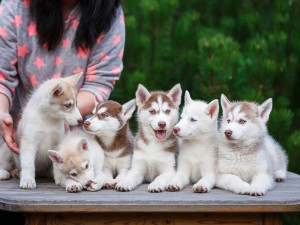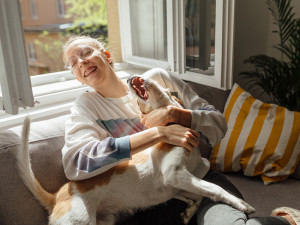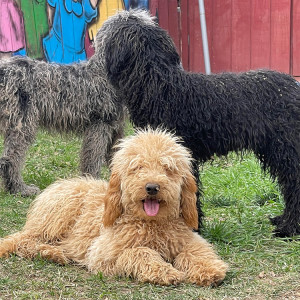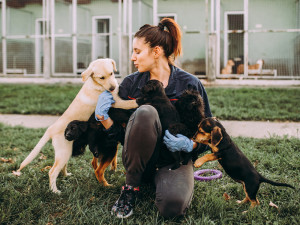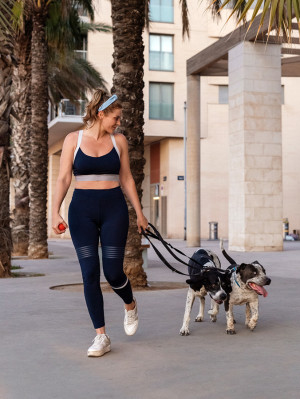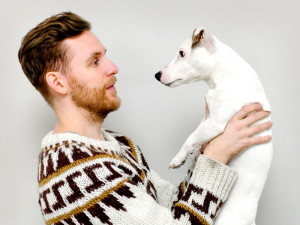Did You Know 25% of Shelter Dogs Are Purebred?
If your heart is set on a purebred pup, start your search at breed-specific rescue organizations.
In all her years of rescue work, the one dog Carolyn Janak will never forget is Spade, a Giant Schnauzer who’d been kept in a small crate for up to 21 hours a day for much of her young life. When Spade was relinquished to Janak’s Denver-based non-profit, HT-Z Giant Schnauzer Rescueopens in new tab, and released into the yard, “she ran like a Greyhound for about 20 minutes…it was the most freedom she’d ever had,” recalls Janak, who for two decades has dedicated herself to rescuing (and living with) Giant Schnauzers.
What are breed-specific rescues?
All abandoned animals deserve such a happy ending, and thanks to the hard work of animal rescuers nationwide, many are given the chance to find loving homes for life. A subset of the animal rescue movement, breed rescues devote all of their resources to a particular type of dog. Depending on the group’s size, it might also take in related breeds, as does Illinois Birddog Rescueopens in new tab, which is devoted to both Pointers and Setters; if resources allow, many breed rescue groups will also take in mixes of their breed.
According to the Humane Societyopens in new tab, one in four shelter dogs is purebredopens in new tab, and many shelters have developed official in-house purebred rescue programs. For example, at the Louisiana SPCA, rescue coordinator Laurie Weisberg keeps track of purebred dogs who come into the shelter and contacts breed rescue groups immediately. This gives the group precious time to find a foster home, raise funds needed for temporary boarding, or make travel plans for the rescue representative. If the dog is a stray and not claimed after the mandatory hold period, a breed rescue volunteer will pull them from the shelter.
When a purebred dog comes into the Roscommon County Animal Shelter in Prudenville, Michigan, animal control officer DeeDee Mendyk, and a volunteer contact the appropriate breed rescue. She believes this gives the dog a better chance of being matched with the right home because the rescue understands its breed’s particular traits and needs. It also frees up space for another dog; when a group pulls a purebred from a shelter, two lives could be potentially saved. The Roscommon shelter often takes in abandoned purebred dogs, such as Beagles and German Shorthaired Pointers, after their respective rabbit-and bird-hunting seasons are over and the hunters no longer have a use for them.
Unfortunately, not all shelters are willing to coordinate with breed rescue groups. “Some are just dog pounds — it’s a misnomer to call them shelters,” says Mary DuPont, a Texas rancher and founder of the national non-profit rescue group Catahoula Rescueopens in new tab. “They’re run by a sheriff, or deputies run them. They give the animals the legal amount of time and don’t want to fool around with rescue. People need to realize that calling it an animal shelter doesn’t necessarily make it a safe haven.”
Who runs breed-specific rescues?
Hundreds, if not thousands, of people across the country volunteer their free time to breed rescue. They can be categorized into three general groups: independent rescuers, non-profit rescue groups, and American Kennel Club (AKC ) parent clubsopens in new tab.
Typically, individuals partial to a particular breed stumble into rescue work. A friend or family member knows they have a soft spot for a breed and brings a dog to their attention, or they happen to learn that a dog of “their” breed is at the local shelter. Sometimes, they’re shelter volunteers who recognize that certain purebreds are not popular adoption candidates because of their size or reputed temperament. They help just one purebred dog; then a second one shows up. Before they know it, they’re breed rescuers.
Often, that one rescuer finds fellow lovers of the breed, and together they pursue nonprofit 501(c)(3) status as an official group. Volunteers raise funds and serve specific administrative roles. They also serve as foster parents, transport coordinators, transport drivers, adoption day coordinators, and more.
The American Kennel Club recognizes more than 150 dog breeds, each of which is represented by a “parent club,”opens in new tab or national breed club made up of people who favor that breed and participate in AKC sanctioned events such as conformation, agility, and obedience. For many parent clubs, rescue is an important part of their mission. But regrettably, not all breeders are willing to admit that their dogs could be abandoned or end up in a shelter.
According to Edith Brackman, longtime breed rescuer and member of the Dalmatian Club of Americaopens in new tab (DCA), supposedly responsible breeders have been known to deny any connection with dogs that come into rescue. For example, on four separate occasions, Brackman contacted the breeders of dogs who ultimately ended up in her care.
Brackman says: “Since I have been a member of DCA for nearly 25 years and have kept all my membership and ethics booklets, I did what I was trained to do: went back and checked membership records. I was terribly disturbed to find two of the four were actually DCA members. The records do not lie, nor do the vets I consulted with.”
Michelle McMullen Salyers, a longtime volunteer with National German Shorthaired Pointer Rescueopens in new tab, which is supported by the AKC parent club, German Shorthaired Pointer Club of Americaopens in new tab, offers another perspective. “Breeders do not have to be the enemy of rescue,” she says. “In the early days of breed rescue, rescuers used to be affiliated through those parent club connections, and many of those volunteers are breeders.”
She says the rescue arm also educates breeders about taking lifetime responsibility for the dogs they bring into the world, and some breeders serve as foster homes or help in other ways. “I have a GSP in Missouri going to a breeder in Arkansas for foster,” McMullen Salyers says. “It’s an important connection when you’re doing breed rescue.”
Where do the dogs come from?
Commercial breeders or puppy mills are perhaps the number-one source of purebred dogs. For these business operations, puppies are “product,” mass marketed over the internet and sold to distributors, who in turn sell them to national pet store chains. If they cannot move them, the puppies are often dumped at shelters. Or, people who impulsively purchase puppies via the web or at a retail store grow tired of the work involved in raising them; at that point, the dogs are turned in at shelters or simply abandoned to fend for themselves.
Fortunately, groups like HSUSopens in new tab have made progress shutting down puppy mills and educating the public about the real cost of patronizing a pet shop. For Bekye Eckert, a volunteer with New Beginnings Shih Tzu Rescueopens in new tab — which also occasionally takes in other “small friends” — rehabilitating puppy mill dogs is her most rewarding experience as a rescuer.
“Most of them come in totally unsocialized,” Eckert says. “They’re terrified, and it just breaks your heart because all you want to do is hold them and love them. Progress is slow, but watching a shut-down little lump on the floor learn how to be a dog is just the greatest high in the world.”
Like all animal rescuers, those focusing on a specific breed spend time with prospective adopters, helping them decide if they are ready for a dog and if their particular breed suits their family and lifestyle. “We definitely try and educate the public,” says Toby Burroughs, president of New Orleans German Shepherd Rescueopens in new tab.
Burroughs continues: “There are a lot of misconceptions about German Shepherds — like Pit Bulls [American Pit Bull Terriers or American Staffordshire Terriers], they are misunderstood. It’s important to know that the German Shepherd is a working breed and needs lots of exercise, mental stimulation, and socialization with people and other dogs. They’re not for everyone. I think people are attracted to their beauty, but often don’t realize that these dogs require more than a bowl of food, water, and a backyard.”
Paula Nowak of New Rattitudeopens in new tab, a Georgia-based Rat Terrier rescue group, finds that on-site events are also great opportunities to advocate for proper care of all dogs. “One big thing we educate on is the need to keep your dog on monthly heartworm preventative and get tested once a year. One heartworm pill a month is much cheaper than treating them after the fact.”
How does breed-specific rescue work?
When a purebred dog arrives at a shelter, a rescue coordinator will take identification photos and notify the appropriate breed rescue via email. Shelters that lack official rescue coordinators are often lucky to have passionate volunteers who are willing to post dogs on national websites and directly email or call the proper rescue organizations.
There are also dog lovers informally known as “shelter surfers” who actively search for purebreds and contact rescues in hope that a dog can be helped. Sometimes, they’ll offer to pull, transport, foster, or donate money toward the dog’s shelter pull fee, medical care, or basic needs if that’s what’s required for the group to take in the dog.
“Shelters from all over the country contact us for help,” says Diane Sacripanti, founder of North Carolina Rottweiler Rescueopens in new tab. “They email the rescue with the information about the dogs they have needing help. We have never had to go to a shelter to look for our breed. The need for Rottweiler rescue is overwhelming. Due to lack of funds and foster homes, we turn away approximately 15 dogs per week.”
In some states, by law, a dog found as a stray must be held for five business days to allow the pet parent a chance to claim them, and when possible, shelters allow the rescue group a little extra time to find a foster home or temporary boarding facility. Most breed-specific rescues rely on private individuals for temporary care of a rescue dog. The dog will stay in their foster home for a few weeks to give them a chance to show their true personality and to address any behavioral, medical, or training issues they may have. They will also receive appropriate health care, including vaccinations, deworming, flea/tick and heartworm preventative, and spay/neuter if necessary.
“The most rewarding part of the job is watching your foster dog blossom under your care,” says Becky Orr, an experienced foster parent for Lab Rescue of the Labrador Retriever Club of the Potomacopens in new tab. “You take in a broken, scared, confused dog, and in several weeks you have a happier and healthier dog, ready to be adopted because of you!”
Prospective adopters fill out an application, provide references, and allow a home visit, during which a volunteer from the breed rescue visits the home to ensure that it offers a safe environment for the dog. Once the prospective adopters have been approved and matched with a dog, they sign an adoption contract that requires the dog be returned to the rescue in the event they are unable to keep them for their lifetime.
For prospective pup parents with a specific type of dog in mind, several benefits come with adopting from a breed rescue. The foster caregivers will be able to share detailed information about the dog’s temperament, health, likes, and dislikes. As mentioned, volunteers can also answer breed-specific questions and help ease the transition from foster care to the new home. Adopters also become part of a larger community comprising fellow adopters and rescue volunteers, and it’s not unusual for adopters to become dedicated volunteers.
In the dark ages of rescue, before iPhones and social media, Dalmatian rescuer Benji Brackman was not shy about using everything at her disposal to save one more spotted dog. “When I started a 501(c)(3) years ago, I begged all my Dal friends, employees, neighbors, and other rescuers to help me out,” says Brackman, who founded Chocolate Chip Dalmatian Assistance Leagueopens in new tab. Now, the internet has completely changed the way rescue operates, allowing everyone involved to coordinate efforts to move a dog to safety within a matter of days instead of weeks, and reducing the risk of the dog being euthanized before the logistics can be worked out.
Wide-reaching websites like Adopt a Petopens in new tab have revolutionized rescue. Reaching a national audience, they allow shelters and rescue groups to post photos and bios of adoptable animals at no charge. This significantly improves adoption rates and increases the pool of volunteers. “If you use tools available electronically, that’s the key to successful rescue,” McMullen Salyers says. “Look at it like a business, market it like a business, find like-minded people, and there’s no way you can’t succeed.”
Social networking sites like Facebook and Twitter have given rescue groups another way to reach the public, spotlight adoptable dogs, announce special events and raise funds for dogs with special needs. Catherine Hedges, president of Don’t Bully My Breedopens in new tab, a 501(c)(3) nonprofit Pit Bull advocacy and rescue group based in Chicago, says, “The three most helpful aspects of social networking are finding fosters, raising funds, and sending out info on pending breed-specific legislation and petitions. Our Facebook group has almost 11,000 members, so I can get urgent info out quickly to a huge number of people. As for individual dogs needing help, we can post a plea asking for donations for boarding an urgent dog and generally reach our goal or find a foster. I would say we do this maybe once a week.”
The future of breed rescues
Breed rescues — like all animal rescue groups — face a number of challenges, but two stand out. One is the sheer number of dogs who need a second chance. Ann Ewing, a volunteer for Weimaraner Rescue of the Southopens in new tab, voices a concern shared by many involved in breed rescue: “The ratio between supply and demand is out of balance. There are simply more dogs than homes. I realize that responsible breeders work to maintain the purity of the breed, but I believe that breeders and rescuers should all work together to reduce the actual number of dogs — at least until we, the rescuers, can catch up.”
The second is a society that views everything (including animals) as disposable. New Beginnings Shih Tzu Rescueopens in new tab volunteer Bekye Eckert recalls just such a situation involving a Lhasa Apso named Macey. “She used to be a beautiful blonde, but was dumped at a shelter because her family couldn’t stand to look at her anymore,” Eckert says. “She had severe allergies that caused hair loss on her underside and legs. Her skin was flaming red and itchy, and her eyes were pretty crusty, too. The shelter was told she was 10 years old. Obviously, in that condition she wasn’t adoptable, and she was depressed to boot.” Eckert later learned that Macey was 13, not 10, and that her former family had recently bought a new puppy.
Miraculously, Macey healed both physically and emotionally and, at 13 years of age, found a loving forever family. “It’s the happy endings that keep me going through the frustration and despair,” Eckert says. “One more little dog in a loving home, and especially one who might have otherwise been overlooked. That’s why I do this work.”
How can I help?
If a particular breed has a special place in your heart, and you would like to get involved with a breed rescue in your area or serve as a local representative for a national group: There are several places to look, including AdoptAPet.comopens in new tab, breed parent clubs affiliated with breed registries (AKC, United Kennel Club), and stand-alone breed specific clubs, such as the Jack Russell Terrier Club of America and the United States Border Collie Club.
For more details, pick up a copy of Rescue Matters! How to Find, Foster and Rehome Companion Animalsopens in new tab, by Sheila Webster Boneham, PhD, an excellent guide that covers everything from rescued dog health to recruiting volunteers to matchmaking with prospective adoptive families.


